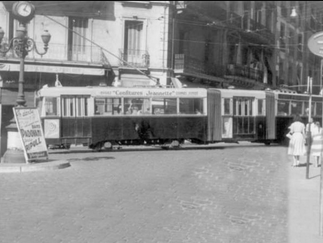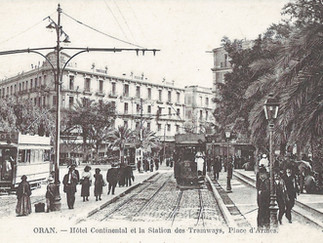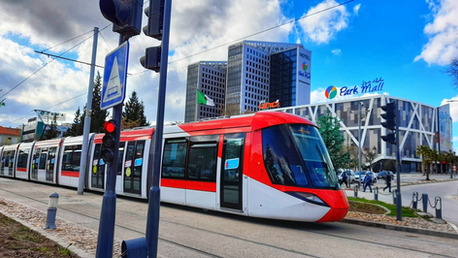The History of Public Transport in Algeria (8/10): the Tramway
- COCKPIT

- Dec 6, 2024
- 7 min read
Updated: Mar 27
The tramway is one of the first forms of public transport set up in Algeria. The establishment of the first horse-drawn tramway networks dates back to Algiers in 1875. A few years later, the electrification of tramways was simultaneous on both sides of the Mediterranean since it took place in France in 1893 and in Algiers in 1896.
At the outbreak of the Second World War in 1939, the Algerian tramway network was considered one of the most modern in the world.

For the tramway in Algeria, we can differentiate two distinct eras, before and after independence.
1/ The tramway network in Algeria from 1892 to 1969
During this period, there were two tramway networks in Algeria: in Algiers and Oran.
1.2/ Algiers tramway

Its first entry into service dates back to 1892 for steam traction and 1898 for electric traction in Algiers, constituted by the Algerian Tramway Company (STM), founded in 1898 under the name of Thomson-Houston subsidiary (future Alsthom). Its development is rapid in view of its efficiency in terms of urban transport and by characteristics responding to the climate and the physiognomy of the city of Algiers.
The first urban transport map of Algiers, dates from 1908, through the network of the regional and urban railway company (CFRA).
Algiers had three separate networks: the CFRA, the TMS and the TA. These three companies had well-defined service sectors and there were few junctions between the respective lines. On the other hand, the technical standards of the three companies were identical: current under 600 volts and gauge of 1.055 m. This unique and specific gauge of Algiers and probably Oran, would be the result of an error when ordering the first railway in Algeria. The person in charge of the order, unaware that the gauge is given between internal faces of rails, thought he was doing the right thing by giving the dimension between axes, i.e. 1.055 m. But the supplier interpreted it as being the dimension between faces.
These three companies had well-defined service sectors:
• The CFRA had both an urban and local vocation. They served the hinterland of Algiers and a coastal line from Castiglione to Aïn Taya, 77 km long, with extensions to Koléa in the west and Rovigo in the east, by steam trains. This line had been put into service in 1892. In 1898, the central, urban section, from “Deux Moulins” to “Maison Carrée”, approximately 17 km, was electrified and operated by tramways.
• Since 1901, the TMS has operated a steeply sloping line that climbs from the city centre to El Biar, Chateauneuf and Ben Aknoun, 9 km away, on the first foothills of the Sahel hills. An extension project was to reach Chéragas, 6 km away and Douéra 17 km from Chateauneuf. The war interrupted the project.
• Since 1898, the TA has operated a long line parallel to that of the CFRA but in the city, from Bab El Oued (Dey Hospital) to Bd Bru and Colonne Voirol.
There were few junctions between the respective lines. On the other hand, the technical standards of the three companies were identical: current under 600 volts and gauge of 1.055 m. This unique and specific gauge of Algiers and probably Oran, would be the result of an error when ordering the first railway in Algeria. The person in charge of the order, unaware that the gauge is defined between internal faces of rails, thought he was doing the right thing by giving the dimension between axes, i.e. 1.055 m. But the supplier interpreted it as being the dimension between faces.
But the most remarkable achievement concerns the modernization of the TA line: in 1934, the company ordered from SATRAMO (Société Anonyme du Tramway Moderne) a prototype of a modern articulated motor car, twenty meters long and mounted on a suspension significantly improved compared to previous equipment. This car could carry 150 people and had self-closing doors with folding steps. Given the success of this equipment, 25 cars were ordered and put into service in 1937. A project to put the trams underground in the city center had been accepted and launched, but interrupted by the war in 1939, and never relaunched. The SATRAMO had been studied with this in mind but continued to provide good service on the surface.
In 1938, the TMS ceased their activity. The line was taken over by the CFRA who converted it into trolleybuses, better adapted to the ramps and tight curves of Rovigo, on the El Biar line. In 1938, after the good results of the trolleybus line of ND d’Afrique, the TA replaced the trams of Bd Bru and Colonne Voirol with trolleybuses, but kept the tram on the Hopital du Dey – Yusuf section, with partial services. For a time, for reasons of saving tires, after the war, a Grande Poste – Galliéni line operated in correspondence with the trolleybuses of El Biar, Hydra and Bd Bru. On the other hand, the trams were kept on the lines along the Port of Algiers (CFRA) and on the main artery of the TA (Yusuf line).
The CFRA operated their lines using high-capacity reversible trains composed of two motor cars flanking a trailer (MRM trains).
In 1939, the Algiers tramway received the prestigious honorary distinction of “the most modern network in the world”.

Jusqu’en 1945, c’était l’antique tramway des CFRA (Chemins de fer sur routes d’Algérie) qui faisait ce service en plus d’une heure comme en 1900.
Après 1945, la circulation devint envahissante dans Alger. Les CFRA transforment la longue ligne de tram des Deux Moulins pour l'exploitation par trolleybus. Puis, vers 1950, c’est la ligne de Kouba, en forte pente, et la longue ligne de Maison Carrée qui, par étapes, passent au trolleybus. La ligne du Ruisseau, exploitée avec des rames réversibles à grande capacité MRM, est maintenue jusqu’au 12 septembre 1959 pour être remplacés par les trolleybus et autobus sur décision de la gestion de la RSTA.

1.2/ The Oran Tramway
Oran is the second city in Algeria to welcome the tramway. It is the decree of public utility of June 5, 1898 which constitutes the birth certificate of the Oran network and is managed by the Oran Electric Tramway Company (TEO). Operation begins on February 3, 1899 with 8 lines which have as a common terminus the Place d'Armes which will later become the Place Foch. December 2, 1951 is the last day of operation of the Oran tramway which will now be provided by bus.

The Oran tram network was operated by TEO (Tram ways Electriques d’Oran). The latter was a subsidiary of CGFT (Compagnie Générale Française de Tramways) which notably operated the Marseille network until 1950, hence sometimes some similarities. Oran is located on the Mediterranean not far from the border with Morocco. During the period that interests us, Algeria is part of France; it is therefore a French tram network. It is the public utility decree of June 5, 1898 that constitutes the birth certificate of the Oran network. Operation began on February 3, 1899 with 8 lines that have as their common terminus the Place d’Armes which would later become the Place Foch.
The Oran trams ran on a track with a gauge of 1.055, just like those of Algiers. The traction current was 600v DC. The capture was done by poles, replaced by Siemens arches around 1925. The current was produced by a thermal steam plant located on rue de Mostaganem. In 1925 it was replaced by a substation equipped with 3 220 Kw switches. From 1953, this substation will be the property of the Société de l’Electricité et Gaz d’Algérie. The depot was located on rue du Colonel Ben Daoud.
In 1920, a departmental electric line from Oran to Aïn el Turck was put into service, independent of the urban network, also operated by the TEO.
In 1926 a new Convention provided for the construction of tracks on the bd du 2ème Zouave allowing the creation of line 7 (Place Foch - Delmonte Bastié) and the electrification between Oran and kilometer 3.5 of the RN6 of the Hamman-Bou-Hadjar line in order to serve the Boulanger suburb (line 8). In return, the tracks on rue Marceau were downgraded, leading to the elimination of line 4.
On January 5, 1936 an amendment provided for the extension of lines 2, 6 and 7.
A part of the original fleet was already reformed in 1915, making way for 20 more powerful Ragheno locomotives, with closed platforms, powered by two 50 hp engines. Some of the locomotives in the original fleet were also vestibulated at this time.
Around 1925, Carel and Fouché locomotives with large wheelbases on Brill trucks were put into service, as well as new Ragheno locomotives.

The first major line closure took place on 1 July 1939, 2 months before the start of the Second World War. This was the Aïn el Turck departmental line, only 19 years after it was put into service. The route would now be operated by SOTAC (Société Oranaise de Transports Automobiles de la Corniche) buses and integrated into the Oran – El Ançor line. On 12 December 1940, an amendment provided for the central terminus to be moved from Place Foch to Place Karguentah. In 1942, the first trolleybuses were used on lines 1 and 1bis (becoming line 0). In 1943, trolleybus line C was created towards Chou pot and in 1944, line Cp towards Cité Petit. In 1947, line 2 was also converted to trolleybuses. In 1949, it was line 6. In 1951, buses took over from tramways on lines 3, 5 and 8. Finally, on December 2, 1951, the last line still operated by tram, line no. 7, was now operated by bus. The Oran tramway network will therefore have lasted 52 years. The trolleybuses will disappear in 1969, despite the addition of around fifteen VA 3 from Algiers after Independence. Operation and ticketing In the 1950s, the service was carried out with 2 agents (seated conductor) on most of the network. The ticket office consisted of Klein Massot slatted tickets and weekly cards, similar to what was done in Marseille. Just like in Marseille, the collection was carried out using CAMP obliterating machines (also called "moulinettes"). The sparrow of Oran, according to Roger ORTEGA, webmaster of the site "Delmonte Mon Quartier". A little anecdote about the bus of line N° 7. There was a stop in front of the Bar Lillo, avenue de Sidi Chami. In this bar a sparrow nested above the counter. Each time the bus arrived, the sparrow entered through the middle door and came out through the front door. It thus visited the bus at each stop in front of the bar. The drivers were used to it and they waited for it to come out before starting.
2/ The new tramway networks in Algeria from 2011
With the evolution of technologies and social mentalities, the tramway is becoming fashionable again in the world and attracts large cities by its practical aspect and especially by its environmental aspect and therefore more ecological than the bus. Algeria adopts this new formula and opts for a massive and rapid reintroduction of the tramway in Algeria. The capital is the first to reintroduce the tramway in the country in 2011, work began in 2006 for Algiers while tramway studies began in 2005 for Constantine and 2006 for Oran.

In 2024, Algeria will have 7 urban networks: Algiers, Oran, Constantine, Sidi Bel Abbés, Ouargla, Sétif and Mostaganem.
The next article will be about cable transport.



































































































Kommentare